
Palazzo Farnese or Farnese Palace is one of the most important High Renaissance palaces in Rome. Owned by the Italian Republic, it was given to the French government in 1936 for a period of 99 years, and currently serves as the French embassy in Italy.

Ca' Rezzonico is a palazzo on the Grand Canal in the Dorsoduro sestiere of Venice, Italy. It is a particularly notable example of the 18th century Venetian baroque and rococo architecture and interior decoration, and displays paintings by the leading Venetian painters of the period, including Francesco Guardi and Giambattista Tiepolo. It is a public museum dedicated to 18th-century Venice and one of the 11 venues managed by the Fondazione Musei Civici di Venezia.

The Doria Pamphilj Gallery is a large art collection housed in the Palazzo Doria Pamphilj in Rome, Italy, between Via del Corso and Via della Gatta. The principal entrance is on the Via del Corso. The palace façade on Via del Corso is adjacent to a church, Santa Maria in Via Lata. Like the palace, it is still privately owned by the princely Roman family Doria Pamphili. Tours of the state rooms often culminate in concerts of Baroque and Renaissance music, paying tribute to the setting and the masterpieces it contains.
Villa del Poggio Imperiale is a predominantly neoclassical former grand ducal villa in Arcetri, just to the south of Florence in Tuscany, central Italy. Beginning as a villa of the Baroncelli of Florence, it was seized by the Medici, became the home of a homicidal and unfaithful husband, and a lavish retreat for a Grand Duchess with imperial pretensions. Later given to Napoleon's sister, it was reclaimed by the hereditary rulers of Tuscany before being finally converted to a prestigious girls' school. During its long history, it has often been at the centre of Italy's turbulent history, and has been rebuilt and redesigned many times.
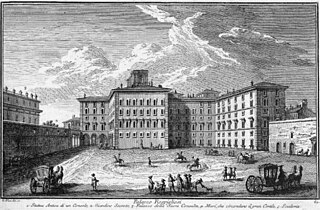
The Palazzo Pallavicini-Rospigliosi is a palace in Rome, Italy. It was built by the Borghese family on the Quirinal Hill; its footprint occupies the site where the ruins of the baths of Constantine stood, whose remains still are part of the basement of the main building, the Casino dell'Aurora. Its first inhabitant was the famed art collector Cardinal Scipione Borghese, the nephew of Pope Paul V, who wanted to be housed near the large papal Palazzo Quirinale. The palace and garden of the Pallavicini-Rospigliosi were the product of the accumulated sites and were designed by Giovanni Vasanzio and Carlo Maderno in 1611–16. Scipione owned this site for less than a decade, 1610–16, and commissioned the construction and decoration of the casino and pergolata, facing the garden of Montecavallo. The Roman palace of this name should not be mistaken for the panoramic Villa Pallavicino on the shores of Lake Como in Lombardy.

The Palazzo Ducale di Mantova is a group of buildings in Mantua, Lombardy, northern Italy, built between the 14th and the 17th century mainly by the noble family of Gonzaga as their royal residence in the capital of their Duchy. The buildings are connected by corridors and galleries and are enriched by inner courts and wide gardens. The complex includes some 500 rooms and occupies an area of c. 34,000 m², which make it the sixth largest palace in Europe after the palaces of the Vatican, the Louvre Palace, the Palace of Versailles, the Royal Palace of Caserta and the Castle of Fontainebleau. It has more than 500 rooms and contains 7 gardens and 8 courtyards. Although most famous for Mantegna's frescos in the Camera degli Sposi, they have many other very significant architectural and painted elements.

The Palazzo Colonna is a palatial block of buildings in central Rome, Italy, at the base of the Quirinal Hill, and adjacent to the church of Santi Apostoli. It is built in part over the ruins of an old Roman serapeum, and it has belonged to the prominent Colonna family for over twenty generations.

Palazzo Borghese is a palace in Rome, Italy, the main seat of the Borghese family. It was nicknamed il Cembalo due to its unusual trapezoidal groundplan; its narrowest facade faces the River Tiber. The entrance at the opposite end of the building, the "keyboard" of the cembalo, faces onto the Fontanella di Borghese, with another in a great flanking facade to the Piazza Borghese that is extended by a slightly angled facade leading down Via Borghese towards the river. Both these entrances lead into a large courtyard on one side of which is a two level open arcade, with paired Doric and Ionic columns, that frames the garden beyond.
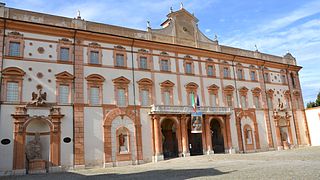
The Ducal Palace in Sassuolo is a Baroque villa located in the town of Sassuolo, thirty minutes outside Modena, northern Italy.

The Chigi Palace is a palace and former noble residence in Rome which is the seat of the Council of Ministers and the official residence of the Prime Minister of Italy. Since 13 February 2021, the tenant of the Chigi Palace has been Prime Minister Mario Draghi. It is located in the Piazza Colonna, next to Palazzo Montecitorio, seat of the Chamber of Deputies.

The Doge's Palace is a historical building in Genoa, northern Italy.

The Royal Palace of Milan was the seat of government in the Italian city of Milan for many centuries. Today, it serves as a cultural center and it is home to international art exhibitions. It spans through an area of 7,000 square meters and it regularly hosts modern and contemporary art works and famous collections in cooperation with notable museums and cultural institutions from across the world. More than 1,500 masterpieces are on display annually.
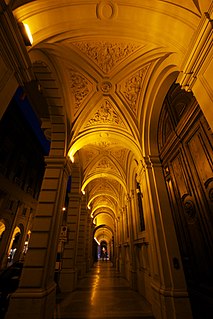
The Palazzo Legnani Pizzardi, also known as Palazzo Pizzardi e Volta or just Palazzo Pizzardi, is a Renaissance style palace located on Via d'Azeglio #38, corner with Via Farini, in central Bologna, Italy. In 2015, the palace housed the Tribunal of Bologna.
Palazzo Zani is a Renaissance palace on via Santo Stefano 56 in central Bologna, region of Emilia Romagna, Italy.
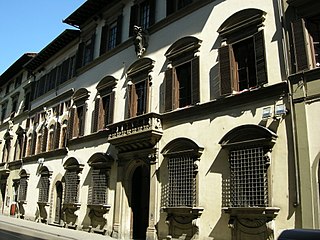
The Palazzo Capponi Covoni is a Baroque architecture palace in Florence, region of Tuscany, Italy. There are apparently three other palaces once associated with the Capponi family:
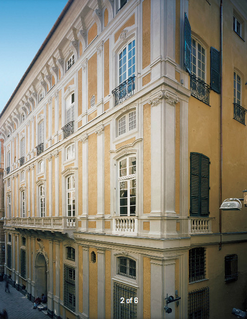
The Palazzo Doria or Palazzo Andrea e Gio. Batta Spinola is a palace located in Via Garibaldi, in the historical center of Genoa, in Northwestern Italy. It was one of the 163 Palazzi dei Rolli of Genoa, the selected private residences where the notable guests of the Republic of Genoa were hosted during State visits. On 13 luglio del 2006 it was included in the list of 42 palaces which now form the UNESCO World Heritage Site Genoa: Le Strade Nuove and the system of the Palazzi dei Rolli.

The Palazzo Malvezzi de' Medici is a Renaissance-style palace located on Via Zamboni #13 in central Bologna, Italy. The palace now houses the offices of the Provincial Administration.
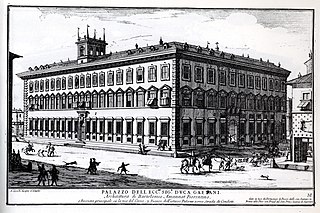
The Palazzo Ruspoli is a Renaissance-style, 16th century aristocratic palace located on Via del Corso 418, where Corso intersects with Largo Carlo Goldoni and the Piazza di San Lorenzo in Lucina, in the Rione IV of Campo Marzio in central Rome, Italy.

Palazzo Sacchetti is a palazzo in Rome, important for historical and artistic reasons.
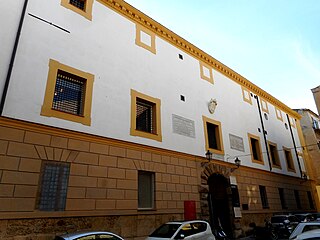
The Palazzo Branciforte is Renaissance-style aristocratic palace located on Via Bara dell'Olivella, in the historic center of Palermo, region of Sicily, Italy. It underwent extensive refurbishment under the direction of the architect Gae Aulenti, and since completion of the work in 2012 has been the home of the Fondazione Sicilia, and houses a modern library, auditorium, and exhibition halls.



















